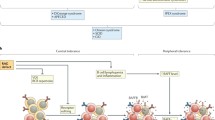Abstract
Background
Primary Immunodeficiencies (PIDs) represent unique opportunities to understand the operation of the human immune system. Accordingly, PIDs associated with autoimmune manifestations provide insights into the pathophysiology of autoimmunity as well as into the genetics of autoimmune diseases (AID). Epidemiological data show that there are PIDs systematically associated with AID, such as immune dysregulation, polyendocrinopathy, enteropathy, X-linked syndrome (IPEX), Omenn syndrome, autoimmune polyendocrinopathy–candidiasis–ectodermal dystrophy (APECED), autoimmune lymphoproliferative syndrome (ALPS), and C1q deficiency, while strong associations are seen with a handful of other deficits.
Conclusion
We interpret such stringent disease associations, together with a wealth of observations in experimental systems, as indicating first of all that natural tolerance to body components is an active, dominant process involving many of the components that ensure responsiveness, rather than, as previously believed, the result of the mere purge of autoreactivities. More precisely, it seems that deficits of Treg cell development, functions, numbers, and T cell receptor repertoire are among the main factors for autoimmunity pathogenesis in many (if not all) PIDs most frequently presenting with autoimmune features. Clearly, other pathophysiological mechanisms are also involved in autoimmunity, but these seem less critical in the process of self-tolerance. Comparing the clinical picture of IPEX cases with those, much less severe, of ALPS or APECED, provides some assessment of the relative importance of each set of mechanisms.
Similar content being viewed by others
References
Carneiro-Sampaio M, Coutinho A. Tolerance and autoimmunity: lessons at the bed-side of primary immunodeficiencies. Adv Immunol 2007;95:50–1.
Geha RS, Notarangelo L, Casanova J-L, Chapel H, Conley ME, Fischer A, Hammarström L, Nonoyama S, Ochs HD, Puck JM, Roifman C, Seger R, Wedgwood J. Primary immunodeficiency diseases: an update from the International Union of Immunological Societies Primary Immunodeficiency Diseases Classification Committee. J Allergy Clin Immunol 2007;120:776–94.
Rosenzweig SD, Holland SM. Defects in the interferon-γ and interleukin 12 pathways. Immunol Rev 2005;3:38–47.
Coutinho A, Caramalho I, Seixas E, Demengeot J. Thymic commitment of regulatory T cells is a pathway of TCR-dependent selection that isolates repertoires undergoing positive or negative selection. Curr Top Microbiol Immunol 2005;293:43–71.
Torgerson T, Ochs HD. Immune dysregulation, polyendocrinopathy, enteropathy, X-linked: forkhead box protein 3 mutations and lack of regulatory T cells. J Allergy Clin Immunol 2007;120:744–50.
Fevang B, Yndestad A, Sandberg WJ, Holm AM, Muller F, Aukrust P, Froland SS. Low numbers of regulatory T cells in common variable immunodeficiency: association with chronic inflammation in vivo. Clin Exp Immunol 2007;147:521–5.
Caudy AA, Reddy ST, Chatila T, Atkinson JP, Verbsky JW. CD25 deficiency causes an immune dysregulation, polyendocrinopathy, enteropathy, X-linked-like syndrome, and defective IL-10 expression from CD4 lymphocytes. J Allergy Clin Immunol 2007;119:482–7.
Cohen AC, Nadeau KC, Tu W, Hwa V, Dionis K, Bezrodnik L, Teper A, Gaillard M, Heinrich J, Krensky AM, Rosenfeld RG, Lewis DB. Cutting edge: decreased accumulation and regulatory function of CD4+ CD25(high) T cells in human STAT5b deficiency. J Immunol 2006;177:2770–4.
Maillard MH, Cotta-de-Almeida V, Takeshima F, Nguyen D, Michetti P, Nagler C, Bhan AK, Snapper SB. The Wiskott–Aldrich syndrome protein is required for the function of CD4+CD25+Foxp3+ regulatory T cells. J Exp Med 2007;204:381–91.
Marangoni F, Trifari S, Scaramuzza S, Panaroni C, Martino S, Notarangelo LD, Baz Z, Metin A, Cattaneo F, Villa A, Aiuti A, Battaglia M, Roncarolo MG, Dupré L. WASP regulates suppressor activity of human and murine CD4(+)CD25(+)FOXP3(+) natural regulatory T cells. J Exp Med 2007;204:369–80.
Curotto de Lafaille MA, Lafaille JJ. The role of regulatory T cells in allergy. Springer Semin Immunopathol 2004;25:295–310.
Kekalainen L, Tuovinen H, Joensuu J, Gylling M, Franssila R, Pontynen N, Talvensaari K, Perheentupa J, Miettinen A, Arstila TP. A defect of regulatory T cells in patients with autoimmune polyendocrinopathy–candidiasis–ectodermal dystrophy. J Immunol 2007;178:1208–15.
Milner JD, Ward JM, Keane-Myers A, Paul W. Lymphopenic mice reconstitute with limited repertoire T cells develop severe, multiorgan, Th2-associated inflammatory disease. Proc Natl Acad Sci USA 2007;104:576–81.
Kemper C, Chan AC, Green J, Brett KA, Murphy KM, Atkinson P. Activation of human CD4+ cells with CD3 and CD466 induces a T-regulatory cell 1 phenotype. Nature 2003;42:388–92.
Marrella V, Poliani PL, Casati A, Rucci F, Frascoli L, Gougeon ML, Lemercier B, Bosticardo M, Ravanini M, Battaglia M, Roncarolo MG, Cavazzana-Calvo M, Facchetti F, Notarangelo LD, Vezzoni P, Grassi F, Villa A. A hypomorphic R229Q Rag2 mouse mutant recapitulates human Omenn syndrome. J Clin Invest 2007;117:1260–9.
Khiong K, Murakami M, Kitabayashi C, Ueda N, Sawa S, Sakamoto A, Kotzin BL, Rozzo SJ, Ishihara K, Verella-Garcia M, Kappler J, Marrack P, Hirano T. Homeostatically proliferating CD4 T cells are involved in the pathogenesis of an Omenn syndrome murine model. J Clin Invest 2007;117:1270–81.
Sobacchi C, Marella V, Rucci F, Vezzoni P, Villa A. RAG-dependent primary immunodeficiencies. Human Mutat 2006;27:1174–84.
Cavadini P, Vermi W, Facchetti F, Fontana SS, Nagafuchi S, Mazzolari E, Sediva A, Marrella V, Villa A, Fischer A, Notarangelo L, Badolato R. AIRE deficiency in thymus of 2 patients with Omenn syndrome. J Clin Invest 2005;115:728–32.
Wong S-W, Roth DB. Murine models of Omenn syndrome. J Clin Invest 2007;117:1213–6.
Cohen IR, Young DB. Autoimmunity, microbial immunity and the immunological homunculus. Immunol Today 1991;12:105–10.
Oliveira JB, Bidère N, Niemela JE, Zheng L, Sakai K, Nix CP, Danner RL, Barb J, Munson PJ, Puck JM, Dale J, Straus SE, Fleisher TA, Lenardo MJ. NRAS mutation causes a human autoimmune lymphoproliferative syndrome. Proc Natl Acad Sci USA 2007;104:8953–8.
Author information
Authors and Affiliations
Corresponding author
Rights and permissions
About this article
Cite this article
Coutinho, A., Carneiro-Sampaio, M. Primary Immunodeficiencies Unravel Critical Aspects of the Pathophysiology of Autoimmunity and of the Genetics of Autoimmune Disease. J Clin Immunol 28 (Suppl 1), 4–10 (2008). https://doi.org/10.1007/s10875-007-9167-y
Received:
Accepted:
Published:
Issue Date:
DOI: https://doi.org/10.1007/s10875-007-9167-y




